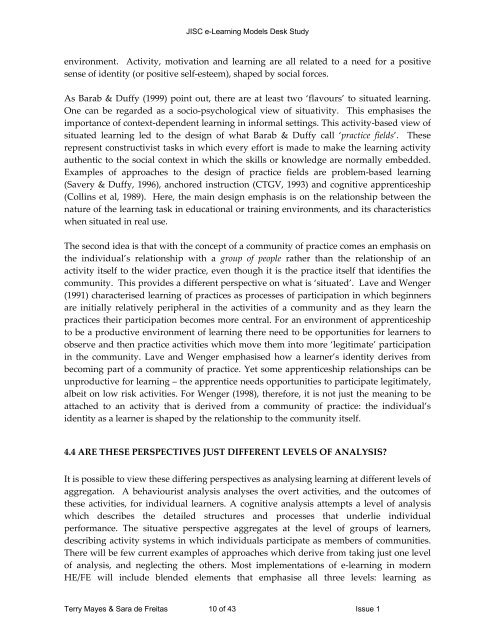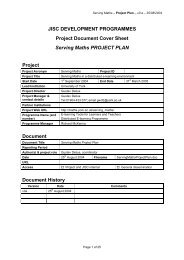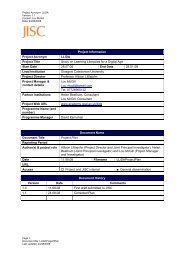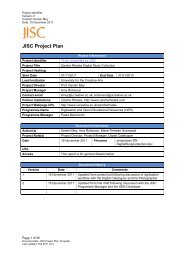Review of e-learning theories, frameworks and models - Jisc
Review of e-learning theories, frameworks and models - Jisc
Review of e-learning theories, frameworks and models - Jisc
Create successful ePaper yourself
Turn your PDF publications into a flip-book with our unique Google optimized e-Paper software.
JISC e-Learning Models Desk Study<br />
environment. Activity, motivation <strong>and</strong> <strong>learning</strong> are all related to a need for a positive<br />
sense <strong>of</strong> identity (or positive self-esteem), shaped by social forces.<br />
As Barab & Duffy (1999) point out, there are at least two ‘flavours’ to situated <strong>learning</strong>.<br />
One can be regarded as a socio-psychological view <strong>of</strong> situativity. This emphasises the<br />
importance <strong>of</strong> context-dependent <strong>learning</strong> in informal settings. This activity-based view <strong>of</strong><br />
situated <strong>learning</strong> led to the design <strong>of</strong> what Barab & Duffy call ‘practice fields’. These<br />
represent constructivist tasks in which every effort is made to make the <strong>learning</strong> activity<br />
authentic to the social context in which the skills or knowledge are normally embedded.<br />
Examples <strong>of</strong> approaches to the design <strong>of</strong> practice fields are problem-based <strong>learning</strong><br />
(Savery & Duffy, 1996), anchored instruction (CTGV, 1993) <strong>and</strong> cognitive apprenticeship<br />
(Collins et al, 1989). Here, the main design emphasis is on the relationship between the<br />
nature <strong>of</strong> the <strong>learning</strong> task in educational or training environments, <strong>and</strong> its characteristics<br />
when situated in real use.<br />
The second idea is that with the concept <strong>of</strong> a community <strong>of</strong> practice comes an emphasis on<br />
the individual’s relationship with a group <strong>of</strong> people rather than the relationship <strong>of</strong> an<br />
activity itself to the wider practice, even though it is the practice itself that identifies the<br />
community. This provides a different perspective on what is ‘situated’. Lave <strong>and</strong> Wenger<br />
(1991) characterised <strong>learning</strong> <strong>of</strong> practices as processes <strong>of</strong> participation in which beginners<br />
are initially relatively peripheral in the activities <strong>of</strong> a community <strong>and</strong> as they learn the<br />
practices their participation becomes more central. For an environment <strong>of</strong> apprenticeship<br />
to be a productive environment <strong>of</strong> <strong>learning</strong> there need to be opportunities for learners to<br />
observe <strong>and</strong> then practice activities which move them into more ‘legitimate’ participation<br />
in the community. Lave <strong>and</strong> Wenger emphasised how a learner’s identity derives from<br />
becoming part <strong>of</strong> a community <strong>of</strong> practice. Yet some apprenticeship relationships can be<br />
unproductive for <strong>learning</strong> – the apprentice needs opportunities to participate legitimately,<br />
albeit on low risk activities. For Wenger (1998), therefore, it is not just the meaning to be<br />
attached to an activity that is derived from a community <strong>of</strong> practice: the individual’s<br />
identity as a learner is shaped by the relationship to the community itself.<br />
4.4 ARE THESE PERSPECTIVES JUST DIFFERENT LEVELS OF ANALYSIS?<br />
It is possible to view these differing perspectives as analysing <strong>learning</strong> at different levels <strong>of</strong><br />
aggregation. A behaviourist analysis analyses the overt activities, <strong>and</strong> the outcomes <strong>of</strong><br />
these activities, for individual learners. A cognitive analysis attempts a level <strong>of</strong> analysis<br />
which describes the detailed structures <strong>and</strong> processes that underlie individual<br />
performance. The situative perspective aggregates at the level <strong>of</strong> groups <strong>of</strong> learners,<br />
describing activity systems in which individuals participate as members <strong>of</strong> communities.<br />
There will be few current examples <strong>of</strong> approaches which derive from taking just one level<br />
<strong>of</strong> analysis, <strong>and</strong> neglecting the others. Most implementations <strong>of</strong> e-<strong>learning</strong> in modern<br />
HE/FE will include blended elements that emphasise all three levels: <strong>learning</strong> as<br />
Terry Mayes & Sara de Freitas 10 <strong>of</strong> 43 Issue 1

















